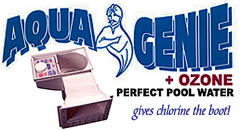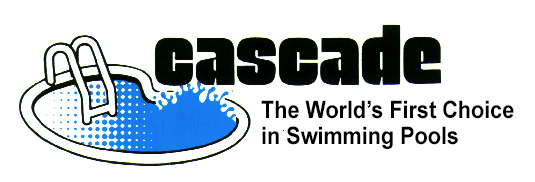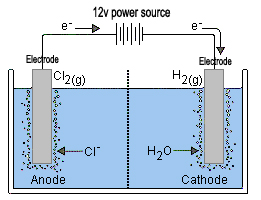BACK IN THE EARLY DAYS OF HOME SWIMMING POOLS IN NEW ZEALAND ...
YOU NEEDED TO PURCHASE CHLORINE FOR YOUR POOL ...
IN LIQUID, OR GRANULAR FORM...
LOTS OF IT!
THE IG450 AQUATECH SALT CHLORINATOR
sOLD FOR $695 WHEN POOLS COST UNDER $2,000
.jpg)

When the average household size 14' x 28' ( 4.3m x 8.6m) family pool was selling installed for less than $2,000.00, $695.00 was expensive (!) - but proved to be a great improvement over the huge $250 "one hundred pound" (35 Kg) drums of granular HTH pool chlorine we included with each Cascade pool sold in those days.
At that time in New Zealand it was illegal to repack powder chlorine (aka Granular Chlorine) into smaller packs, and the HTH brand granular chlorine could not even be stocked in drums or sold without a Dangerous Goods license, so customers had to take the full size drum. This was a problem to keep tightly sealed, and the chlorine gas emmitted when the lid was constantly being removed was extremely hazardous.
|
The AQUATECH IG450 - a World First?
The IG450 device was conceived and developed in the early 1970's by Cascade's Laurence E (Larry) Ogden following a discussion a with scientist friend who questioned the need to buy chlorine when it could be created in the pool water? Thinking about how to accomplish this prompted the development of the first commercial home pool "chlorine-maker".
Larry continued experimenting with his invention, and when considered approved, the IG450 "Salt Chlorinator" was manufactured by newly established company Cascade Industries Limited.
Marketing was done by Cascade's offshoot wholesale and retail company "Aquatech Industries Limited" while operating as a wholey owned branch of Cascade Industries Limited. (Aquatech is no longer a part of Cascade Industries).
The chlorinator was intended for the average size "in-ground" home pool of 45k liters - or 10,000 gallons in the "old" money - hence the name 'IG450' (IG for In Ground and 45,000 litres capacity). This product was intended for in-ground home swimming pools, to take over from the necessary bulky Drums of granular chlorine currently being provided to customers.
The IG450 design had stainless steel four-plate electrodes - which had an expected lifetime of two to three years, and $250 to replace. This was a high cost in those days.
Later developments (the IG450A) used a Platinum electro-plated stainless steel electrode which lasted 3 to 4 times as long, but cost twice as much to replace. Nevertheless, these 1970's units were sold by the thousands, ... and contemporary salt units based on our design dominate the world market these days.
|
SELF-CLEANING UNITS
In 1974 Cascade introduced the IG450B polarity switching Utilising MOSFET electronics developed in 1959 - a Metal Oxide Semi-conductor Field Effect Transistor, which reversed the DC '+Positive' and '-Negative' current every minute or so. reversing the polarity dumped the accumulated "gunk" off the platinum electrode giving the "appearance" of an extended service cycle between acid washes,
and was sold as "Self Cleaning" (continuing to this day) but of course the dumped gunk soon reattached itself, so it wasn't really "Self Cleaning".!
The polarity reversing idea seemed good at the time, but the electrodes gradually continued to build up a thin coating of calcium from shock dosing periodically with Cal-Hypo (Calcium Hypochlorite (Ca [OCL2] ) - which inhibited the production.
To clean the Electrode: Customers had to periodically dismantled the unit and give a bath in dilute hydrochloric acid to "freshen" the electrode. The polarity switching is still being used by Salty manufacturers today, but as stated it is a short term solution to the problem of calcium buildup and gradual deterioration of the electrode.
It wasn't until many years later - 1994, in fact - that we (being simple Pool builders) fully appreciated the chemistry involved and swimmer safety requirements of swimming pool water. After all, the pools 'never went green' and so our customers smiled and everybody was happy!
We didn't know at the time, but the chlorinator electrodes also created Sodium Hydroxide (NaOH aka Caustic Soda) - commonly known in New Zealand as DRAINO drain unclogger!
Unfortunately (1.) ,The old saying 'no free lunches' came true. We were 'structural engineers' NOT chemical engineers - just as many "pool builders' are today - despite the availability of a Pool Maintenance Diploma Course by the NZ Pool Industry Association!
Unfortunately (2.), We had overlooked the production of sodium hydroxide pH (Caustic Soda NaOH) - being equal in quantity with the sodium hypochlorite production - and as a consequence, the pool pH was always extremely high. as the pH of Caustic Soda tops out at 14 (on a scale of 0 - 14) and Sodium Hypochlorite has a pH of 11.0 - 13.0
|
The pool pH rose so high, in fact, that the sterilisation of the pool is in jeopardy, as once the pH exceeds 8.0 there is literally no effective sanitisation taking place, and the pool water is constituting a health and safety risk to the users - if the pool owner was unaware of - and did not take action to reduce - the high pH situation!
The Fix? Dosing the pool with liters of Hydrochloric Acid and ensuring it is stored and maintained safely became a necessary and regular task!
AS A HOME POOL OWNER, YOU SHOULD UNDERSTAND THIS CHART...
|
.jpg)
Our final version IG450C incorporated a fluid acid pump to remedy the high pH situation, but the IG450C unit Retail Cost soared to $2,800.00 plus GST the cost of the 40 litre drum of hydrochloric acid which was inconveniently located adjacent to the pool filtration if a locked shed was not provided.
The presence of such large quantities of dangerous acid also posed a questionable risk to children who might have access to the filtration area.
After 25 years of using 'Saltys' CASCADE abandoned the idea OF SALT CHLORINATION!
Seeing this as an extreme safety hazard for young - and curious - children, in 2004 we discontinued the installation of salt chlorinators in favour of the US made Aquagenie Skimmer/Feeder system - which we still use today in conjunction with an activated oxygen generator (Ozone or O3).
|
| |
Other problems we encountered with salt water pools includes (1.) premature corrosion of metal pool equipment and general pool surrounds, (2.) the need to top the pool up with heavy 25kg bags of salt as rainfall dilutes the pool water, and (3.) the need to periodically acid wash the electrode to remove calcium coating which is reducing the performance of the unit.
Voltage Leakage: The issue of "voltage leakage was a major problem in the early days, as the "stray voltage" in the pool water tended to destroy the culprod pool pump and pool heater internals in a short time! These pumps are not in use these days.
Oh ... and the danger to pool users if they "shorted out" to earth while standing in the pool (i.e. while standing in the pool, don't grab anything "Earthed" outside of the pool - such as a stainless steel pool ladder )!
Swimmers with PaceMakers (Heart monitors) were deemed to be at risk, according to one medical advisor, but I had no feedback on the accuracy of this warning. |
Cascade circumvented the voltage leakage problem to a large degree by installing an Earth Strap from the pool ladder to an earth.
In later years, as stainless steel pool ladders went out of fashion in favour of internal "walk out" stairs in pools - but be caution of hand-rails, Cascade started installing bi-metal earth plate bolited internally in the pool skimmer and connected to an earth wire and earthed to the steel pool frame.
We continue with this practise to this day - even though we don't generally fit saline chlorinators to our pools any more - in favour of passive Ozone - we still include the Earth Strap wire - in case a future home owner retrofits a "Salty" or other device at some later stage - without contacting Cascade first!
We don't want our pools to constitute a hazard even
if CASCADE was not directly responsible! |
| |
My 'Salt Chlorinator' Big Idea
was to take the IG450 to the USA in 1973:
Big Mistake!
I took two US required Underwriters Laboratories approved IG450 sample units to America for displaying on the CASCADE NJ 1973 Chicago Trade Fair (I Think that's what it was called) in Illinois, USA. Great interest was shown in the two Samples and the previously unheard-of concept of creating Chlorine directly in the pool water.
In fact my sample IG450s were so popular at the Show that both 'went missing' on the clean-up after the show! The Show management were unable (or unwilling) to assist me in recovering them and even refused to call the Local Police.
I guess I was just too young too trusting, and too inexperienced ...
so I returned to New Zealand without them.
The following year I returned to the same Show with the improved IG450C but sold none - possibly due to the proliferation of similar looking locally made copy units on display.
- Even ones painted bright Yellow like ours - and apparently being copied in such diverse places as South Africa, Mexico and Australia.
SUMMARY:
In the period 1965 to 1973, having spent years personally involved in the residential Swimming Pool Industry in the USA, United Kingdom, Europe, and New Zealand, I had never seen any similar pool device creating Chlorine in swimming pools, available on the Home Swimming Pool equipment market.
Also, I have been unable to find evidence of any use of such a device prior to my introduction onto New Zealand sales market of the IG450 - although I have heard an anecdotal story of a similar development in Tasmania Australia around that time, but nothing that was readily available on the home or overseas Pool Industry market - so until I learn of an alternative, I must assume that ...
"In 1972 'Larry Ogden and Cascade Industries New Zealand were the commercial originators of residential Salt Water Pool Chlorinators".
PATENT: In 1972 I explored obtaining a World Patent for the IG450, but the cost quoted at $US 33,000 - the $NZ was par at that time was too much for a young 30 year old to come up with - especially as I had recently bought a three-bedroom house on a quarter-acre in a nice Auckland suburb with sea views for $NZ 16,000.
I recently had my current Patent Lawyer Mr. Piper (Auckland NZ) check the possible pool equipment world on line, and I saw a years old Mexico Patent Application "under process" vaguely similar in principle to my IG450 (but not in appearance, or having been developed for home pools).
In the mid 1970's, checking the US and other countries I subsequently learned from my Patent Attorney at the time that the World Patent would have meant fighting a Patent case personally in each of the countries that were making similar devices - at a cost of more than $50,000 each time - it was beyond my resources to do so!
They didn't bother to advise me of this detail previously (Quote: "You want Legal Advice? We are the Patent Office... Legal is the next door up the corridor")
- but I guess that's lawyers for you! |
| |
Why don't we use saLT chlorinators today?
21st Centry Salt Chlorinators have evolved from the day of my original invention, so this entire article has no intention to berate or dismiss the modern "salties" - of which I have no knowledge of...
I just don't know - all I do know is that CASCADE using OZONE+UV has proven to work 100% for us over the past 22 years and thousands of pools, so we have no intention to stop using the AquaGenie+Ozone system until something better comes up.

In my opinion, Cascade's combined Aquagenie+Ozone system is better, cheaper to operate and more reliable at sterilising pathogens & bacteria in the home swimming pool than other methods - making your pool cleaner and safer for your children.
And after all - isn't that the whole idea?
Click AQUA GENIE graphic above
for more information on the Aquagene+Ozone system

ITBOMK, Without Prejudice and E&OE (C) 2024
Updated and Checked for veracity June 2024 |


.png)

.jpg)